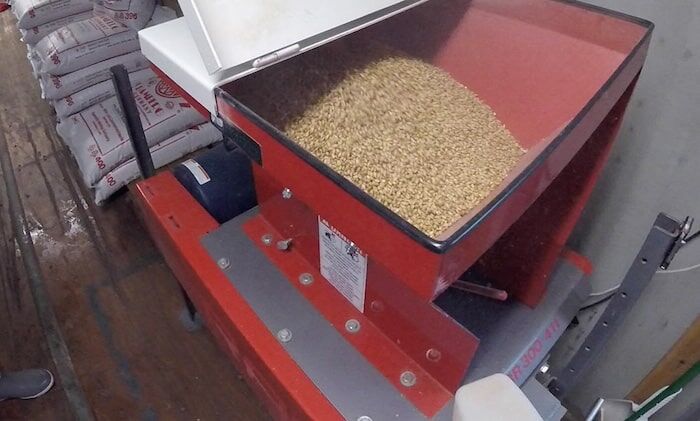Brewery Mills
Brewery mills are roller mills with 2-6 rollers. Using roller mills improves yield and consistency, minimizes dust, and bypasses the maintenance of screens. Hammer mills can be necessary for distillers who need the higher throughput, but greater quality can be reached with rollers.
Brewery mill choice comes down to roller size, roller quantity, and quality. Quality is determined by reliability, dust egress, and general heft, which translates to grind consistency.
Roller Length
Regardless of roller quantity, initial surface area determines throughput. As you can see from the table below, this is determined by length. Width contributes to longevity and consistency. The greater the consistency of the grind, the more consistent the end product. And the more tightly you can control the grind, the less particulates you have. And since particulates reduce yield, less of them means you can have better yield.
Roller Width & Weight
The heavier and wider the rollers of a mill, the more consistent your grinds. Greater consistency in your grain allows you to turn out a more consistent beer or spirit. It also lets you avoid particulates, also known as fines.
Roller Quantity
More rollers means more control. With a second pair of rollers the first pair can be backed off, bringing the grains down to a consistent size and reducing jarring on the second pair. This lets you keep more husks in-tact and reduce the presence of fines. Because particulates don’t yield alcohol, less of them means higher yields so thicker and more rollers means slightly better yields. Less fines also means less dust in your environment.
Build Quality
Facets of build quality other than roller weight and size include the control mechanism of the rollers itself, how dust-tight the connections are, and the quality of components including the motor. A higher-quality mill will require less service, will be easier to repair when it’s needed, and will create a lot less noise and dust. Less dust means cleaner air, cleaner floors, and fewer pests. This is particularly important because once insects and rodents have been attracted, they are extremely difficult to get rid of.
All sourced equipment is provided for the same price or lower that individuals can get direct.
The value we add to the manufacturer in exchange for a discount is volume, and the value we add for the brewer is they can receive sales and service for their whole system from one point of contact.
RAD vs. RMS
40-60 lbs/min
Strong quality and minimalistic
40-60 lbs/min
Super sturdy, dust-tight, & quiet
Choosing a Brewery Mill
For brewers, mill quality usually comes down to RAD vs. RMS, a simple matter of budget. Getting a heavier-duty mill off the bat will surely cost less in the long run due to repairs and down-time. But if you really need that extra money now and financing rates are high, a lighter mill will be better.
As reflected in the table, there is some overlap of when certain models are viable depending on recipes and how many runs you do in a day. The key is to make sure your mill can finish batches at least as quickly as your minimum mash time and go from there.
In general this table goes higher in quality as you move right, but the exception is the RMS 6×6. This is the model they made to compete in the lower price bracket and is the only reason RMS and RAD’s prices overlap.
| System Size ( BBL) | RAD 2-Roller | RAD 4-Roller | RMS 2-Roller | RMS 4-Roller |
| 3-10 | 6.5″ x 4.5″ (40 lbs/min) | N/A | 6″ x 6″ (20 lbs/min) | N/A |
| 7-20 | 6.5″ x 7.5″ (60 lbs/min) | 6.5″ x 7.5″ (60 lbs/min) | 9″ x 6″ (50 lbs/min) | 9″ x 6″ (50 lbs/min) |
| 15-40 | 6.5″ x 7.5″ (60 lbs/min) | 6.5″ x 7.5″ (60 lbs/min) | 9″ x 12″ (83 lbs/min) | 9″ x 12″ (83 lbs/min) |
| 30-60 | N/A | N/A | 9″ x 18″ (167 lbs/min) | 9″ x 18″ (167 lbs/min) |
| System Size ( BBL) | RAD 2-Roller | RAD 4-Roller | RMS 2-Roller | RMS 4-Roller |
| 3-10 | 6.5″ x 4.5″ (40 lbs/min) | N/A | 6″ x 6″ (20 lbs/min) | N/A |
| 7-20 | 6.5″ x 7.5″ (60 lbs/min) | 6.5″ x 7.5″ (60 lbs/min) | 9″ x 6″ (50 lbs/min) | 9″ x 6″ (50 lbs/min) |
| 15-40 | 6.5″ x 7.5″ (60 lbs/min) | 6.5″ x 7.5″ (60 lbs/min) | 9″ x 12″ (83 lbs/min) | 9″ x 12″ (83 lbs/min) |
| 30-60 | N/A | N/A | 9″ x 18″ (167 lbs/min) | 9″ x 18″ (167 lbs/min) |
System Size
RAD 2-Roller
RAD 4-Roller
RMS 2-Roller
RMS 4-Roller
3-10 BBL
6.5″ x 4.5″ (40 lbs/min)
N/A
6″ x 6″ (20 lbs/min)
N/A
7-20 BBL
6.5″ x 7.5″ (60 lbs/min)
6.5″ x 7.5″ (60 lbs/min)
9″ x 6″ (50 lbs/min)
9″x6″ (50 lbs/min)
15-40 BBL
6.5″ x 7.5″ (60 lbs/min)
6.5″ x 7.5″ (60 lbs/min)
9″ x 12″ (83 lbs/min)
9″ x 12″ (83 lbs/min)
30-60 BBL
N/A
N/A
9″ x 18″ (167 lbs/min)
9″ x 18″ (167 lbs/min)
